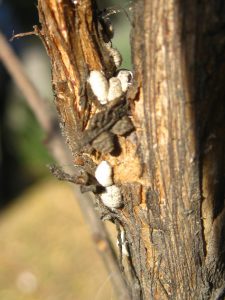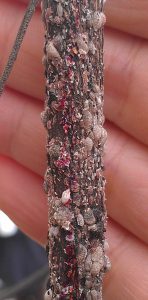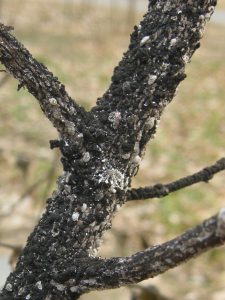
Crapemyrtle bark scale are often found in branch crotches and wounds to the bark. Photo credit: Gary Knox, UF/IFAS.
There is a new pest in the western panhandle of Florida. Crapemyrtle bark scale (CMBS) is a scale that is found on the trunks, branches, and twigs of crapemyrtle. It is the only known scale insect found on the bark of crapemyrtle. There are other scales that occur on the leaves.
When scouting for this pest, look for very small (2 mm or 0.08 inch) white or light gray spots on the bark of crapemyrtle. The adult females do not ever move once they have found a place to feed and reproduce. Under her protective covering, she lays eggs that hatch into ‘crawlers’ that then crawl away to find their own spot to settle down. When squished, they exude a pink goo (the eggs or newly hatched crawlers). Males are winged and travel to find their mates. See this comprehensive information on their interesting biology.
While the scale does not outright kill the trees, it lessens their landscape value and can reduce flowering. And like other scale, CMBS secretes lots of honeydew; black sooty mold then feeds and grows on the honeydew. The black sooty mold does not harm the plants directly, but it is unsightly and can interfere with photosynthesis if present on the leaves.

Crapemyrtle bark scale are white to gray and ooze pink when squished. Photo credit: Gary Knox, UF/IFAS. ,
Unfortunately, CMBS has also been found on a very popular native bush, American beautyberry, Callicarpa americana, and it is yet unknown whether CMBS will expand its host range to other plant species in our country. In Asia, this pest has been found on some economically important crops like pomegranate and persimmon.
CMBS is a tough insect to control. And it is best left to the professionals. Dr. Adam Dale, an entomologist at the University of Florida, recommends using pyriproxyfen (in the product Distance) or buprofezin (in the product Talus). These are insect growth regulators that have shown to provide great control of CMBS and other similar scale insects on trees and other woody plants. Although these products are not systemic, they are translaminar, which helps increase their control and reduce any non-target effects on beneficial insects like bees. Two applications 7–14 days apart are suggested. However, these products can only be applied by licensed pest control applicators.

Severe infestation of crapemyrtle bark scale and sooty black mold. Photo credit: Gary Knox, UF/IFAS.
Systemic insecticide drenches are effective but pose a dangerous hazard to bees and other pollinators as the poison also gets into the flower nectar. The product labels prohibit application of these type of products to flowering plants for that very reason.
Routine close inspection of your crapemyrtle trees is critical for CMBS control. Early treatment will help prevent heavy infestations as seen in some of the photographs. When pruning your crapemyrtles, thoroughly clean your tools between plants to prevent any accidental spread.
Prevent this scale from coming into your landscape in the first place. Inspect all new plants you are considering adding to your landscape for any sign of CMBS or other insect or disease presence.
If you have any questions on making the correct identification of CMBS, or any other insect, contact your county extension office.
Lastly, consider reporting the presence of this new scale to enable researchers to track its spread.
For more information:
UF/IFAS Featured Creatures: crapemyrtle bark scale
- Sugar Belle Mandarin: A Great Choice for the Florida Panhandle - November 22, 2021
- LandscapeQ & A - August 20, 2021
- Let’s Talk Beneficial Insects - August 18, 2021
